Lesson 18.1: The Biodiversity Crisis
Lesson 18.1: The Biodiversity Crisis
Lesson Objectives
Compare humans to other species in terms of resource needs and use, and ecosystem service benefits and effects.
Define the concept of biodiversity.
Quantify Earth’s species diversity, according to scientists’ current understanding.
Describe patterns of biodiversity in space.
Trace changes in biodiversity throughout Earth’s history.
Examine the evidence for the Sixth Extinction.
Compare the Sixth Extinction to major extinctions before humans.
Discuss the direct economic benefits of biodiversity.
Evaluate ecosystem services provided by biodiversity.
List the intangible (cultural, spiritual, religious) benefits of biodiversity.
Relate biodiversity to social and political stability.
Consider that biodiversity has intrinsic value apart from benefits to humans.
Assess the potential for early human activities to contribute to Ice Age extinctions of large animals.
Identify habitat loss as the primary cause of the Sixth Extinction.
Relate the introduction of exotic species to loss of biodiversity.
Explain the extent to which over exploitation has affected all levels of biodiversity.
Connect energy use to extinction.
Describe the effects of population growth and unequal distribution of resources on biodiversity.
Recognize that pollution of water, land, and air contributes to the loss of species.
Acknowledge that your daily activities and decisions can significantly help to protect
biodiversity.
Evaluate your consumption – of food, clothing, furniture, and cleaning products.
Appreciate the importance of water resources and know how to use them wisely.
Evaluate your choice and use of energy sources.
Assess the importance of minimizing waste, and of using best practices for waste dis- posal.
Know how to avoid transporting and releasing exotic species.
Realize that you can practice sustainable management of your own land, from small yards to local, state, and federal lands which also belong to you.
Describe sustainability and its role in decision-making.
Explain how learning and active citizenship can contribute to protecting biodiversity.
Introduction
Humans, like all species, depend on certain natural resources for survival. We depend on land and soils to grow crops, which transform solar energy into food. We use the Earth’s freshwater lakes, rivers, and groundwater for drinking. We rely on the atmosphere to provide us with oxygen and to shield us from radiation. We rely on Earth’s biodiversity for food, clothing, and medicines. We utilize all of the “basic four” (biodiversity, land, water, air) for recycling of nutrients and disposal of waste. Natural ecosystems, as Odum suggests, provide services for all species: they maintain soil, renew the atmosphere, replenish freshwater supplies, dispose of wastes, and recycle nutrients. In our dependence on these services, we are like all other species.
Yet in many ways, we do not behave like other species. We supplement food and animal energy with fossil fuel energy. We harvest natural resources to exhaustion, and produce waste beyond levels that the Earth can process. We alter biodiversity, land, water, air and fossil fuels beyond nature’s ability to repair. As you learned in your study of population biology, our population has grown beyond Earth’s carrying capacity, compounding problems of resource use and waste disposal. Only recently have we learned to appreciate the full value of these resources – and the potential for harm from our own activities. Our economics have not caught up to our relatively new understanding: we do not yet pay the costs of maintaining all of “nature’s services.”
This lesson will explore biodiversity – the “millions of organisms and hundreds of processes
- operating to maintain a livable environment.” The topic is timely, critical, and colorful: you will encounter warnings of a Biodiversity Crisis and the Sixth Extinction, and species identified as “an Elvis taxon” or “a Lazarus taxon.” More importantly, by the end of your study, you will have some tools you can use in your daily life to help protect the great diversity of Earth’s life.
What is Biodiversity?
“The first rule of intelligent tinkering is to save all the pieces.” –attributed to Aldo Leopold, but probably a shortened version of: ”To save every cog and wheel is the first precaution of intelligent tinkering.” - Aldo Leopold, Round River: from the Journals of Aldo Leopold, 1953
What are the “cogs” and “wheels” of life?
Although the concept of biodiversity did not become a vital component of biology and political science until nearly 40 years after Aldo Leopold’s death in 1948, Leopold – often considered the father of modern ecology - would have likely found the term an appropri- ate description of his “cogs and wheels.” Literally, biodiversity is the many different kinds (diversity) of life (bio-). Biologists, however, always alert to levels of organization, have identified three measures of life’s variation. Species diversity best fits the literal trans- lation: the number of different species (see the chapter on Evolution of Populations ) in a particular ecosystem or on Earth (Figure 18.1). A second measure recognizes variation within a species: differences among individuals or populations make up genetic diversity. Finally, as Leopold clearly understood, the “cogs and wheels” include not only life but also the land (and sea and air) which supports life. Ecosystem diversity describes the many types of functional units formed by living communities interacting with their environments.
Although all three levels of diversity are important, the term biodiversity usually refers to species diversity. How many species do you think exist on Earth? What groups of species do you think are most abundant? Consider your own experience, and your study of biology up to this point. Think carefully, and write down your answer or exchange ideas with a classmate before you read further.
What is the Species Diversity of Earth?
There are three good answers to this question. As a member of one of Earth’s most intriguing species, you should know them all!
Estimates vary widely – from 2 million to 117.7 million, underlining our lack of knowledge. Most estimates fall between 5 and 30 million. Much remains to be learned about the diversity of microorganisms. For example, scientists have recently discovered that Archaebacteria – originally considered limited to extreme environments - may constitute as much as 40% of the ocean’s microbial biomass. Few species have been identified. Estimates of global diversity of the better-studied Eubacteria vary from millions to billions, with orders of magnitude of error. As for multicellular organisms, the most “species-dense” terrestrial ecosystems, such as coral reefs and tropical rain forests, harbor most of the undiscovered species (Figure 18.3). Ironically, these ecosystems are also disappearing quickly. In summary, our estimates of biodiversity remain crude. However, the following conclusion is clear: given the current rapid loss of species, we will never know many of the species we are losing.
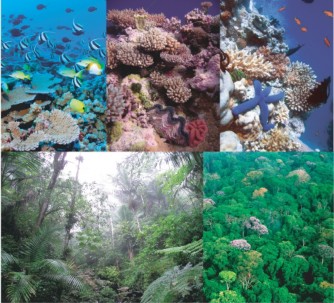
Biodiversity Patterns in Space
Are Earth’s 1.8 million known species evenly distributed across its surface? You may already be aware that the answer is a resounding “No!” We will compare two regions with relatively high diversity to begin our analysis.
Minnesota has relatively high ecosystem diversity, because three of the Earth’s six major terrestrial biomes converge in this state (Prairie, Deciduous Forest, and Coniferous Forest). By contrast, Costa Rica comprises almost entirely of Tropical Rain Forest, and has only one quarter of the land area of Minnesota (Figure 18.4).
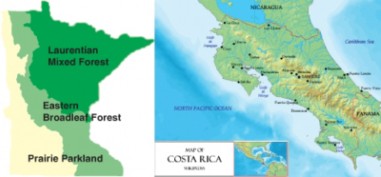
Figure 18.4: The state of Minnesota (left) includes three major biomes and four times the land area of the country of Costa Rica (right), which is predominately a tropical rainforest. Figure 18.5 compares the biodiversity of Minnesota to that of Costa Rica. (8)
You might expect, then, that Minnesota would have a higher species diversity. Several groups of organisms are compared in the Figure 18.5. Note that a column is included for you to research your own state or region!
Clearly, biodiversity is much higher in Costa Rica than in Minnesota. Collecting leaves for your biology class in Costa Rica, you would need to study 2,500 different trees in order to identify the species! And you’d need to look carefully to distinguish tree leaves from those of the many epiphytes (plants which grow on top of others), vines, and strangler figs which climb the trunks and branches, “cheating” their way to the sunlight at the top of the canopy. In Minnesota, keys to native trees include just 42 species of conifers and deciduous broadleaved species. There, vines are relatively rare, and epiphytes are limited to colorful lichens.
The differences in biodiversity between Minnesota and Costa Rica are part of a general worldwide pattern: biodiversity is richest at the equators, but decreases toward the poles. Temperature is undoubtedly a major factor, with warmer, equatorial regions allowing year- round growth in contrast to seasonal limitations nearer the poles.
Generally, the more species, the more niches – so diversity begets diversity.
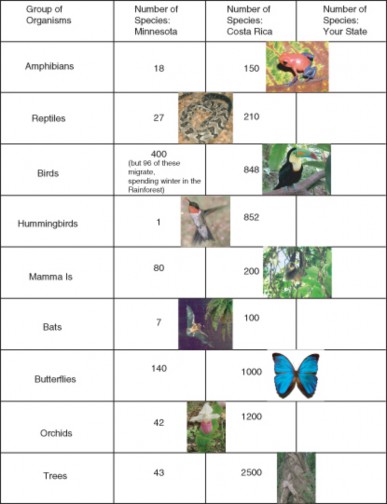
Does your country, state or region fit the general pattern of decreasing biodiversity from equator to poles?
Biodiversity Patterns in Time
How has Earth’s biodiversity changed across time? The fossil record is our window into this pattern, although the window has limitations. Microorganisms are poorly preserved and distinguished only with difficulty; gene sequence studies of living bacteria have begun to fill in some missing data. For all organisms, recent rock layers are more accessible and better preserved than ancient ones.
Despite these drawbacks, fossils and gene studies show a distinct pattern of increasing bio- diversity through time. As discussed in the chapter on the History of Life, the origin of life is not clearly understood; evidence suggests that life did not appear on Earth until perhaps 4 billion years ago. For several billion years, unicellular organisms were the only form of life. During that time, biodiversity clearly increased, as Eubacteria and Archaebacteria emerged from a common ancestor some 3 billion years ago, and Eukaryotes emerged by endosymbio- sis about 2 billion years ago. However, we have not accurately measured the diversity of even today’s microorganisms, so we have little understanding of changes in the diversity of microorganisms beyond these major events.
The emergence of multicellular life about 1 billion years ago certainly increased biodiversity, although we have little way of knowing whether it might have negatively affected the diversity of microorganisms. Fossils remain relatively rare until the famed Cambrian explosion 542 million years ago. Since then, a much more detailed fossil record (Figure 18.6) shows a pattern of increasing biodiversity marked by major extinctions.
The dramatic increase indicated for the last 200 million years is somewhat disputed. Some scientists believe it is a real increase in diversity due to expanding numbers of niches – diversity begets diversity, again. Others believe it is a product of sampling bias, due to better preservation of more recent fossils and rock layers. Most scientists accept the general pattern of increasing diversity through time, interpreting the magnificent biodiversity of life on Earth today as the result of billions of years of evolution.
Most scientists also accept at least the five major mass extinctions shown in Figure 18.6, and some hold that regular cycles govern extinction. Causes for these extinctions (more com- pletely discussed in the History of Life chapter) remain incompletely understood; hypotheses include global climate change, major volcanic and continental drift events, dramatic oceanic change, and/or extraterrestrial impact or supernova events.
Increasingly accepted is a current Sixth or Holocene Extinction event. According to a 1998 survey by the American Museum of Natural History, more than 70% of biologists consider the present era to be a sixth mass extinction event - perhaps one of the fastest ever. We will explore the Sixth, or Holocene, Extinction in the next section of this lesson.
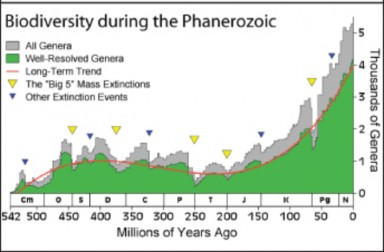
The Current Loss of Biodiversity
“For one species to mourn the death of another is a new thing under the sun.”
-Aldo Leopold A Sand County Almanac, 1949
Over 99% of all species that have ever lived on Earth are extinct. During the 5 major ex- tinctions recorded in the Phanerozoic fossil record (Figure 18.6), more than 50% of animals disappeared. Evidently, extinction is natural. However, current extinctions may differ sig- nificantly in rate and cause. The IUCN (International Union of Concerned Scientists) has documented 758 extinctions since 1500 CE; for example, 6 species of giant, flightless Moa (Figure A 18.7) disappeared from New Zealand shortly after the arrival of Polynesians. Estimates of extinctions for the last century range from 20,000 to 2,000,000 species; as for diversity, we simply do not know the true figure.
Many scientists begin the Sixth Extinction with the Ice Age loss of large mammals and birds
Scientists have identified about 1.8 million species. (Figure 18.2)
The relative numbers of species in each of the six kingdoms of life is shown in Figure A
18.2. The Animal Kingdom (dominated by the Insects, as shown in Figure B 18.2) includes the great majority of known species, and Archaebacteria, by far the fewest. Most scientists agree that Eubacteria and Archaebacteria are seriously underrepresented, due to their small size and chemistry-based diversity. This leads to a second, and perhaps better answer to our question:
No One Knows How Many Species Currently Live on Earth!
Does this lack of knowledge surprise you? Scientists are still discovering new species - not only microorganisms but also plants, animals, and fungi. At least 5 new species of marsupials,
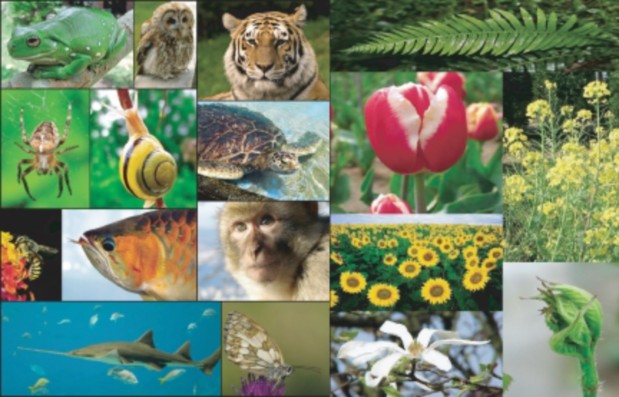

25 primates, 3 rabbits, 22 rodents, 30 bats, 4 whales or dolphins, a leopard, and a sloth were identified between 2000 and 2007 – and these include only mammals! The vast majority of Eubacteria, Archaebacteria, Protist, and even Insect species may be yet unknown because their small size, remote habitats, and the chemical distinctions between species make them so difficult to detect. These challenges, however, have not prevented scientists from estimating Earth’s biodiversity – bringing us to the third answer to our question:
Scientists Estimate that Between 5 and 30 Million Species Inhabit the Earth.
part of a continuum of extinctions between 13,000 years ago and now. During that time, 33 of 45 genera of large mammals became extinct in North America, 46 of 58 in South America, and 15 of 16 in Australia. Climate change and/or human “overkill” are hypothetical causes. Supporting the significance of the “sudden” arrival of humans are the low numbers in Europe and South Africa, where humans had coevolved with large animals. The woolly mammoth (Figure B 18.7) is one of the many examples of large mammal extinctions from this period.
The first species to become extinct during recorded human history was the Dodo (Figure C 18.7), a flightless bird which had evolved without predators on an island in the Indian
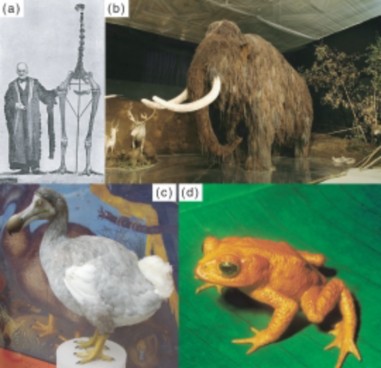
Figure 18.7: A gallery of species which have succumbed to the Sixth Extinction: A: one of six species of Moa birds which disappeared after Polynesians first arrived and began to hunt and clear forests in New Zealand about 1500 CE. B: reconstruction of a woolly mammoth, one of many large mammals which became extinct at the end of the last Ice Age, due to human hunting, disease, and/or climate change. C: a reconstruction of the meter-tall flightless Dodo, which disappeared within a hundred years of its discovery, probably due to forest destruction and introduced predators. D: the Golden Toad recently discovered in 1966, has been officially extinct since 1989. Amphibians as a group have declined sharply throughout the world during the past three decades. (7)
Ocean. Described in 1581, the fearless Dodo experienced hunting, forest habitat destruction, and introduced predators, and became extinct before 1700 – a story repeated for many more species over the following three centuries. Unfortunately, the story extends back in time, as well; over the past 1100 years, human activity has led to the extinction of as many as 20% of all bird species… a tragic loss of biodiversity.
Harvard Biologist E.O. Wilson estimated in 1993 that the planet was losing 30,000 species per year - around three species per hour. In 2002, he predicted that if current rates continue, 50% of today’s plant and animal species will be extinct within the current century – compared to hundreds of thousands or even millions of years for pre-human mass extinctions. A dramatic global decline in amphibian populations in less than 30 years headlines the recent rise in extinction. Herpetologists report that as many as 170 species have become extinct within that time, and at least one-third of remaining species are threatened. Costa Rica’s Golden Toad (Figure D 18.7), first described in 1966, was last seen in 1989 and has become a poster species for amphibian declines.
Why is Biodiversity Important? What are We Losing?
Why should humans care if biodiversity declines? Does it matter that we have 170 fewer amphibians, or that we are losing thousands of species each year, when the Earth holds millions of other species, and life has been through extinction before? The answer is a definitive yes! It matters to us even if we consider only the economic and spiritual benefits to humans. It matters to us because we do not even understand the myraid of indirect benefits – now recognized as ecosystem services- that we reap from other species. And, of course, it matters to other species as well.
Direct Economic Benefits of Biodiversity
Food Supply: Monocultures (large-scale cultivation of single varieties of single species) are extremely vulnerable to disease. A water mold caused the infamous Irish potato famine where potatoes had been bred from a single Incan variety. As recently as 1970, blight swept the corn belt where 80% of maize grown in the U.S. was a single type. According to the Food and Agricultural Organization of the United Nations, humans currently cultivate only 150 plant species, and just four provide over half of the food we eat. Just 15 animal species make up over 90% of our livestock.
Potential for hybridization requires a diverse “bank” of wild, native species. Contemporary breeders increase genetic diversity by hybridizing crop species with wild species adapted to local climate and disease (Figure 18.8).
Clothing, Shelter, and Other Products: As many as 40,000 species of plants, animals, and fungi provide us with many varied types of clothing, shelter and other

products. These include timber, skins and furs, fibers, fragrances, papers, silks, dyes, poisons, adhesives, rubber, resins, rubber, and more.
Energy: In addition to these raw materials for industry, we use animals for energy and transportation, and biomass for heat and other fuels. Moreover, hydroelectric power depends on ecosystem structure: Chinese scientists calculated that the economic benefits of maintaining forest vegetation in the Yangtze River watershed “produced” more than twice the economic value of timber (had it been harvested) in annual power output.
Medicine and Medical Models: Since the first microorganisms competed for food, evolution has been producing chemicals for “warfare” and “defense” in bacteria, fungi, plants, and animals; Figure 18.9 shows several used by humans. According the Amer- ican Museum of Natural History Center for Biodiversity Conservation (AMNH-CBC), 57% of the most important prescription drugs come from nature, yet only a fraction of species with medicinal potential have been studied.
Unique features of certain species have opened windows into how life works. For example, the Atlantic squid’s giant axon revealed the basics of neurophysiology, and the horseshoe crab’s (Figure D 18.11) optic nerve and photoreceptors taught us how vision works. Other animals serve as disease models; as far as we know, other than humans, only armadillos suffer from leprosy, and only sea squirts form kidney stones.
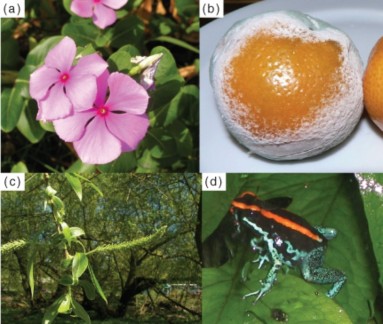
Figure 18.9: A pharmacopoeia of the living world: The Rosy Periwinkle (A) is the source of two chemotherapy drugs effective against leukemias. The mold Penicillium (B) produces the antibiotic penicillin to defend its territory (in this case, a mandarin orange) from competing microorganisms. Aspirin originates in the bark of the White Willow (C). And several species of tropical frogs in the genus Phyllobates (D) produce poisons used by South American tribes for hunting with darts. (46)
Efficient Designs: Inspiration for Technology: Biomimicry, also known as biomimetics or bionics, uses organisms for engineering inspiration and human inno- vation. Rattlesnake heat-sensing pits, for example, suggested infrared sensors. Zim- babwe’s Eastgate Centre Figure 18.10 incorporates air-conditioning principles from termite mounds. The 2006 Mercedes-Benz Bionic employs the body shape of the yel- low box fish to combine high internal volume and efficient aerodynamics. Biomimetics professor Julian Vincent estimates that only 10% of current technology employs the highly efficient biological designs crafted by evolution and natural selection. Loss of biodiversity can be viewed as the loss of millions of years of evolutionary wisdom.
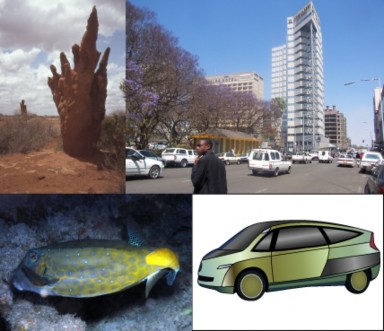
Figure 18.10: Bionics, or biomimicry, engineers structures based on biological designs made efficient by millions of years of evolution and natural selection. Above: The air-conditioning efficiency of a termite mound (left) inspired the design of the Eastgate Centre in Zimbabwe (right), which requires just 10% of the energy needed for conventional building of the same size. Below: The rigid exoskeleton and low-drag body shape of the tropical yellow box-fish (left) inspired the 2006 Mercedes-Benz Bionic (right), which combines large internal volume with optimal aerodynamics. (37)
Warnings of Toxins and Other Ecosystem Disruptions: If you know how miners use canaries to detect poisonous gases underground, you will understand how widespread extirpation of peregrine falcons (Figure E 18.11) warned us about the dangers of the pesticide DDT and food chain concentration of toxins.
Indirect Benefits of Biodiversity: Ecosystem Services
Increasing Ecosystem Productivity: Ecologist David Tilman compared grassland plots to show that increasing species diversity increased overall productivity (yield). Different plants utilize different resources, so a variety of plants may more completely use resources within an area. As noted above, diversity also reduces system vulnera- bility to pests and disease.
Increasing Ecosystem Stability: Tilman observed his grassland plots through several cycles of drought and documented a similar relationship between biodiversity and stability. Plots which were more diverse were more resistant to drought and later recovered more completely. Reducing ecosystem vulnerability to pests and disease may also be a factor in the relationship between diversity and stability. As you have learned before, diversity among individuals within a species increases the chance that at least some will survive environmental change; similarly, diversity among species within an ecosystem increases the chance that at least some species will survive environmental change.
Maintaining the Atmosphere: As you learned in the chapters on photosynthesis and respiration, plants and algae produce the O2 which makes up 20% of the atmo- sphere essential to aerobic organisms, and remove CO2 produced by respiration and burning fossil fuels. As Joseph Priestley expressed this service, plants “restore the air” which has been “injured by the burning of candles” or “infested with animal respira- tion.” O2 is also critical to life because it helps to maintain the ozone shield, protecting life from dangerous Ultra-Violet radiation.
Maintaining Soils: Soil microorganisms maintain nutrients in complex but critical chemical pathways. Vegetation and litter prevent erosion of soils which require thou- sands of years to form. Estimates suggest that erosion destroys as many as 3 million hectares of cropland annually, and that as much as one-fifth of the world’s cropland is “desertified” through salination, acidification, or compacting.
Maintaining Water Quality: Water treatment plants rely in large part on microor- ganisms for water purification, and natural systems do the same. In nature, wetland, waterway, and watershed root systems combine with soil adsorption and filtration to accomplish water purification. When New York City decided to restore the Catskill wa- tershed, their $1-1.5 billion investment in “natural capital” contrasted favorably with the $6-8 billion initial cost and $300 million annual operating cost of a new treatment plant.
“Fixing” Nitrogen: One of the most amazing aspects of biological systems on earth is their absolute need for nitrogen – to build the proteins and nucleic acids upon
which life depends – and their nearly universal dependence on microorganisms to “fix” atmospheric N2 gas and recycle the nitrogen of waste and death. Only after the bacterial “service” of processing nitrogen is it available in usable chemical form to plants, and through them, to animals (Figure A 18.11).
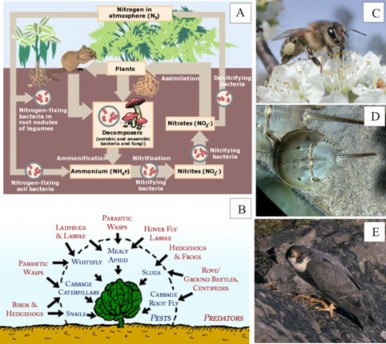
Nutrient Recycling and Waste Disposal: Bacteria and nitrogen are not the only contributors to the waste management services of ecosystems. Fungi, protists, and scavengers help to decompose waste and dead organisms so that new life can reuse the available nutrients.
Pollination: The list of biotic pollinators, essential for sexual reproduction in many plants, is long including not only insects such as wasps, bees, ants, beetles, moths, butterflies, and flies, but also fruit bats and birds such as hummingbirds, sunbirds, spiderhunters, and honeyeaters. Although U.S. crops have relied on commercial hon- eybees (which are “migrated” to keep pace with maturing crops!), native pollinators in nearby forests or wild grasslands have been shown to improve the productivity of ap- ples or almonds by 20%. The American Institute of Biological Sciences estimates that native insect pollination is worth $3.1 billion annually. Current alarm over honeybee colony collapse highlights the importance of biodiversity to the ecosystem service of pollination.
Pest and Disease Control: According to the AMNH-CBC, farmers spend $25 billion annually on pesticides, while predators in natural ecosystems (Figure B 18.11) contribute 5 to 10 times that value in pest control. Costs associated with the use of chemical pesticides (such as water pollution) add to the value of natural pest control. Natural enemies are adapted to local environments and local pests, and do not threaten each other’s survival (or ours!) as do broad-spectrum chemical pesticides. Preservation of natural enemies is associated with preservation of plant diversity, as well. Disrupted ecosystems can lead to increasing problems with disease. In Africa, deforestation has led to erosion and flooding, with consequent increases in mosquitoes and malaria.
Aesthetic Benefits of Biodiversity
Cultural, Intellectual, and Spiritual Inspiration: Music, art, poetry, dance, mythology, and cuisine all reflect and depend on the living species with whom we share the Earth. Our cultures reflect local and regional variations, and as such, biodi- versity underlies our very identities. The beauty and tranquility of living ecosystems have inspired environmentalists (Rachel Carson, Aldo Leopold), spiritualists (Thomas Berry), and writers such as (Barry Lopez) throughout history. Recently, the increasing distance of human society from the natural world has raised concerns about our psy- chological and emotional health; E.O. Wilson has proposed that biophilia (love of the living world) is an increasingly ignored part of our human psyche, and Richard Louv believes that too many of our children suffer from “nature deficit disorder” caused by our increasing alienation from nature.
Recreational Experiences: Many people choose to use vacation and recreation time to explore natural ecosystems. Outdoor recreational activities – many of which are in- creasing in popularity - include hunting, fishing, hiking, camping, bird-, butterfly- and whale- watching, gardening, diving, and photography. Indoor hobbies such as aquari- ums also celebrate biodiversity. For Costa Rica, Ecuador, Nepal, Kenya, Madagascar, and Antarctica, ecotourism makes up a significant percentage of the gross national product. Ideally, ecotourism involves minimal environmental impact, conservation of bio- and cultural diversity, and employment of indigenous peoples.
Political and Social Benefits of Biodiversity
Some analysts relate biodiversity to political and social stability. Unequal access to food, clothing, water, and shelter provided by diverse ecosystems threatens social equity and sta- bility. Land ownership and land use practices which threaten biodiversity often marginalize poorer people, forcing them into more ecologically sensitive areas and occupations. Poverty, famine, displacement, and migrations are problems related to loss of biodiversity which have already led to billions of dollars in relief costs and significant local armed conflict.
Intrinsic Value of Biodiversity
Many people value biodiversity for its inherent worth, believing that the existence of such a variety of genes, species, and ecosystems is reason enough for our respect. Intrinsic value goes beyond economic, aesthetic, environmental, and political benefits. For many people, intrinsic value alone imposes great responsibility on us to monitor our actions in order to avoid destroying the diversity of life.
Why is biodiversity important? It supplies us with essential resources, raw materials, and designs which have direct economic value. It enhances the stability and productivity of ecosystems which in turn provide essential, under-appreciated services. These services, too, have great economic value, although we are only beginning to recognize their importance as we experience their loss. Biodiversity is critical for cultural identity, spiritual and intellectual inspiration, and our own re-creation. Biodiversity goes hand-in-hand with social and political stability. And for many people, biodiversity has inherent worth apart from its many benefits for us and our environment.
Biodiversity is critically important for us and for the Earth, and it is declining at an un- precedented rate. What is causing current extinctions? What can we – what can YOU – do to help?
Causes of the Sixth Extinction: Human Actions and the Environment
What are the causes of the Sixth Extinction? There is nearly universal agreement that most result from human activities (Table 18.1 and Figure 18.12). Although our activities have changed, we remain the single species most able to alter the Earth’s genetic, species, and ecosystem biodiversity.
Continent/Island Human Settlement (Years Before Present)
Extinctions Which Followed
Africa, Eurasia Humans evolve here relatively few extinctions
Indonesia 50,000 50% of large mammal species
Australia 40,000 55 species large mammals, reptiles, and birds
Table 18.1: (continued)
Continent/Island Human Settlement (Years Before Present)
Extinctions Which Followed
![]()
North and South Amer- ica
10,000 - 12,500 70-80% of large mammals (at least 135 species) within 1000 years
Mediterranean Islands 10,000 large mammals and reptiles
West Indies 7,000 Mammals, birds, reptiles all 5 endemic mammals of Puerto Rico
Madagascar 2,000 virtually all large endemic land mammals, reptiles, and birds within 1500 years
Hawaiian Islands 1,500 (Polynesians) 250 (Eu-
ropeans)
2/3 of native vertebrate species, 90% of bird species after European arrival, 20 more bird species
New Zealand 1,300 No mammals originally Frogs, lizards, and over 1/3 (40 species) of birds
Convincing evidence for human responsibility for Ice Age extinctions is outlined in Figure
Although the data above has led to considerable agreement about human responsibility for the early Holocene extinctions, scientists still debate exactly how human activities caused extinctions. Hypotheses include:
These effects of early human habitation foreshadow today’s even greater threats to biodiver- sity. Overpopulation, industrialization, technology, cultural differences, and socioeconomic disparities compound the six major causes of today’s Biodiversity Crisis. Most experts agree on the primary cause of extinction today:
Causes of Extinction #1: Habitat Loss
Habitat loss, degradation and fragmentation is universally accepted as the primary threat to biodiversity. Agriculture, forestry, mining, and urbanization have disturbed over half of Earth’s vegetated land. Inevitably, species disappear and biodiversity declines.
Conversion for agriculture is a major reason for habitat loss. Within the past 100 years, the area of land cultivated worldwide has increased 74%; grazing land increased 113%. Agri- culture has cost the United States 50% of its wetlands and 99% of its tallgrass prairies. Native prairie ecosystems (Figure 18.13) - which comprise of thick, fertile soils, deep-rooted grasses, a colorful diversity of flowers, burrowing prairie dogs, owls and badgers, herds of bison and pronghorns, and booming prairie chickens, - are virtually extinct.
The largest cause of deforestation today is slash-and-burn agriculture (Figure 18.14), used by over 200 million people in tropical forests throughout the world. Depletion of the surprisingly thin and nutrient-poor soil often results in abandonment within a few years, and subsequent erosion can lead to desertification. Half of Earth’s mature tropical forests are gone; one-fifth of tropical rain forests disappeared between 1960 and 1990. At current rates of deforestation, all tropical forests will be gone by 2090.


Poverty, inequitable land distribution, and overpopulation combine in third world coun- tries to add pressure to already stressed habitats. Use of firewood, charcoal, crop waste, and manure for cooking and other energy needs further degrade environments, threatening biodiversity through habitat loss.
Causes of Extinction #2: Exotic (Alien or Invasive) Species
Technology has made the human species the most mobile species of any which has ever lived. Both intentionally and inadvertently, humans have extended their mobility to a great number of other species, as well. Ships from Polynesian times (as long ago as 3500 BP) to the present have transported crop species and domesticated animals as well as stowaway rats and snakes. Recently, cargo ships have transported Zebra Mussels, Spiny Waterfleas, and Ruffe deep into the Great Lakes via ballast water. Europeans brought Purple Loosestrife and European Buckthorn to North America to beautify their gardens. Shakespeare enthusiast Eugene Schieffelin imported the now-ubiquitous European Starling to Central Park in the 1890s because he thought Americans should experience every bird mentioned in the works of Shakespeare. Australians imported the Cane Toad in an attempt to control the Cane Beetle, a native pest of sugar cane fields. The Brown Tree Snake (Figure 18.15) may have hitchhiked in the wheel-wells of military aircraft to Guam - and subsequently extirpated most of the island’s “naïve” vertebrate species.
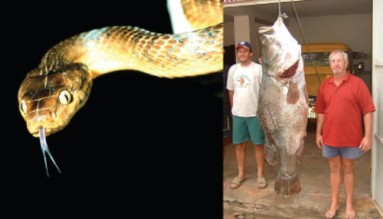
Many of these exotic (non-native) species, away from the predation or competition of their native habitats, have unexpected and negative effects in new ecosystems. Freed from natural controls, introduced species can disrupt food chains, carry disease, out-compete natives for limited resources, or prey on native species directly - and lead to extinctions. Some hybridize with native species carefully tuned to local climate, predation, competition, and disease, resulting in genetic pollution which weakens natural adaptations. Others change the very nature of the habitats they invade; Zebra Mussels, for example, colonize most manmade and natural surfaces (including native mussels), filter-feeding so intensely that they increase water clarity and enrich bottom habitats with their waste.
Globalization and tourism are increasing the number of exotics which threaten biodiversity throughout the world, breaking down geographic barriers and threatening the wisdom of millions of years of evolution and natural selection. If current trends continue, our increas- ingly interconnected world will eventually be dominated by just a few fast-growing, highly adaptable, keenly competitive “super-species” rather than the rich diversity we have today. Some biologists, noting that invasive exotics closely resemble what we consider to be “weed” species, have concluded that the world’s #1 weed species is – did you guess it? – none other than Homo sapiens.
Causes of Extinction #3: Overexploitation
The modern equivalent to overkill, overexploitation threatens fisheries, tropical rain forests, whales, rhinos, large carnivores and many other species. Practices such as clear-cutting old growth forests, strip mining, and driftnet fishing go beyond harvesting of single species or resources to degrade entire ecosystems. Technology-aided over-harvesting has reduced one of the richest fisheries in the world - the Grand Banks off the coast of Newfoundland – to an estimated 1% of what they were in 1977 (Figure 18.16). In 2003 in the journal Nature, Canadian biologists published an analysis of data showing that “industrialized” fishing has reduced large predatory fish worldwide by 90%. Some species’ stocks are so depleted that less desirable species are illegally sold under the names of more expensive ones; in 2004, University of North Carolina graduate students tested DNA from fish sold as “red snapper” from eight states and found that different species made up 77% of the fish tested! Overex- ploitation happens on the level of genes and ecosystems as well as individual species. Forest plantations, fish hatcheries and farms, and intensive agriculture reduce both species diversity and genetic diversity within species.

Causes of Extinction #4: Global Climate Change
Our increasing reliance on fossil fuels is altering the Earth’s atmosphere and climate. The effects include acid rain, breaks in the ozone layer shielding us from ultraviolet radiation, and greenhouse gases which raise the Earth’s air and ocean temperatures and sea levels. Burning tropical rain forests compounds the effect, releasing carbon as CO2 and eliminating the forest’s ability to sequester carbon – remove carbon as CO2 from the atmosphere
Comparing Ice Age to pre-human extinctions provides more evidence:
Ice Age extinctions affected large animals disproportionately; pre-human extinctions affected all body sizes.
Ice Age extinctions occurred at different times in different regions; pre-human extinc- tions were global and simultaneous.
Recent extinctions follow human migration with regularity.
The “syncopated” pattern does not fit climate change, and earlier interglacial periods did not see similar extinctions.
Overkill: Animals outside Africa and Eurasia evolved in the absence of humans. Many
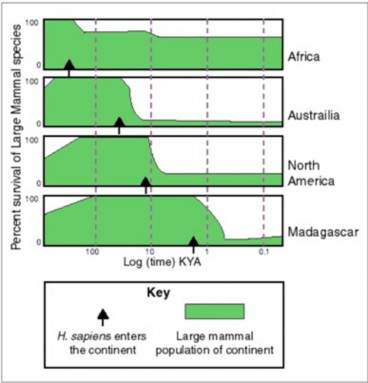
did not fear humans and would have been easily killed, explaining the disproportionate numbers of large species affected.
Cascade effects: Extinctions of very large animals could have had major effects on
ecosystems, including secondary extinctions. Loss of predators could have led to over- population and starvation of prey species. Loss of large herbivores would have affected their predators. Removal of even a single keystone species could have destabilized complex ecosystem interactions, leading to multiple extinctions.
Disease: Humans often brought along rats, birds, and other animals as they migrated to new regions. Animals in those new regions, however, would not have evolved re- sistance to the diseases they carried. Avian malaria, for example, is still spreading through Hawaii, having already caused the extinctions of many bird species.
Predation by exotic animals: The rats, birds, and other animals accompanying humans brought not only disease but also new appetites to regions where animals had evolved without predators. Like humans, these animals found the “naïve” prey easy to capture.
Habitat destruction: Deforestation and agriculture accompanied humans, and the loss of habitat inevitably resulted in loss of species.
via photosynthesis. Inevitably, changing air and water temperatures, rainfall patterns, and salinity threaten species adapted to pre-warming conditions, and biodiversity declines globally. This concern is the topic of the Climate Change Lesson .
Causes of Extinction #5: Overpopulation
In 1960, Earth’s human population stood at 3 billion. By 1999, we had grown to 6 billion. This unprecedented growth, together with developments in technology, has added immense pressure to resource and land use. Overpopulation compounds all of the aforementioned threats to biodiversity, and unequal distribution of resources extends the consequences to social and political instability. Human population growth continues (see the chapter on Bi- ology of Populations). Growth rates vary – ominously, from a biodiversity perspective: the highest rates are in third world tropical countries where diversity is also highest. We have al- ready seen how slash-and-burn agriculture and Lake Victoria fisheries connect socioeconomic changes to loss of biodiversity.
Causes of Extinction #6: Pollution
Pollution adds chemicals, noise, heat or even light beyond the capacity of the environment to absorb them without harmful effects on life. To a certain extent, pollution has not kept pace with population growth, at least in Europe and the US. Startling events such as the oil- and-debris-covered and lifeless Cuyahoga River catching fire in 1969 finally provoked the U.S. to stop viewing air and waterways as convenient dumping grounds for waste. Environmental legislation, including the establishment of the Environmental Protection Agency (EPA) has improved both water and air quality. Heeding the warning provided by the extirpation of the Peregrine Falcon from the Eastern U.S., scientists discovered that many synthetic chemicals concentrate as they move through the food chain (biological magnification), so that toxic effects are multiplied. DDT – the cause of the Peregrine’s decline – was banned in the U.S., and regulation of pesticides was transferred from the Department of Agriculture to the EPA.
And yet, pollution continues to contribute to habitat degradation worldwide, especially in developing countries.
Air Pollution: Knows no boundaries and growing concern about its effects on climate earn this topic two lessons later in this chapter. Acid rain, ozone depletion, and global warming each affect diversity.
Water Pollution: Especially from threatens vital freshwater and marine resources in the US and throughout the world. Industrial and agricultural chemicals, waste, acid rain, and global warming threaten waters which are essential for all ecosystems. Threats to water resources are discussed in Lesson 2.
Soil Contamination: Toxic industrial and municipal wastes, salts from irrigation, and pesticides from agriculture all degrade soils - the foundations of terrestrial ecosys-
tems and their biodiversity. These and other threats to soils are discussed in Lesson 2, Natural Resources.
Outside the developed world, pollution controls lag behind those of the U.S. and Europe, and developing nations such as China are rapidly increasing levels of pollution. Many pollution problems remain in industrialized countries, as well: industry and technology add nuclear waste disposal, oil spills, thermal pollution from wastewater, light pollution of the night skies, acid rain, and more to the challenges facing Earth’s biodiversity. Many will be discussed in the following lesson on Natural Resources, and you can certainly research more about those which interest or concern you. Our next task will be to switch from the doomsday report of problems and causes to a discussion of what WE – ordinary citizens – can do to help protect Earth’s biodiversity.
Protecting Biodiversity
Consider the following facts from the American Museum of Natural History’s Center for Biodiversity and Conservation (AMNH-CBC) and the Environmental Protection Agency (EPA):
Every year, Americans:
Throw away at least 2 billion disposable razors
Discard enough paper and wood to heat 5 million homes for 200 years
Drink more than two billion gallons of bottled water, costing 900 times more money than tap water – not counting the energy and toxics involved in packaging and shipping
Retire up to 130 million cell phones, containing toxic metals such as arsenic, cadmium, and lead
Generate about 3 million tons of toxic electronics waste (e-waste), and recycle only about 11%
Do any of these everyday experiences apply to you? You may be surprised to learn there is quite a lot you can do to help. Read carefully through the suggestions below, noting those that appeal to you strongly and those which seem most feasible. Many involve little more than awareness in decisions you already or will soon make.
Consume Thoughtfully and Wisely: Reduce Your Consumption Where Possible. Re-use, and Recycle. Make Durability and Effi- ciency Your Criteria for Product Purchases.
In general, when you buy:
Buy locally whenever possible to reduce transportation costs for you and for the envi- ronment.
Be aware of the natural resources used to make and transport any product you buy.
Substitute other materials for plastics - which are made from petroleum and produce toxic waste.

Figure 18.17: Eat with the environment and your health in mind! In the United States, the Department of Agriculture (USDA) sets standards for organic products and certification. The green-and-white seal identifies products which have at least 95% organic ingredients. The program is helpful to consumers, but not without controversy (read Barbara Kingsolver’s Animal, Vegetable, Miracle, and/or Michael Pollan’s Omnivore’s Dilemma). (48)
When you buy food plan your diet for your own health and that of the environment.
Eat low on the food chain. Top carnivores get the least energy and the most poison.
Buy local produce in season – to reduce transportation costs and the need for pesticides.
Buy at farmers’ markets or a Community Supported Agriculture (CSA) programs to support local farmers and reduce demand for energy-consuming and polluting large- scale agriculture and marketing.
Choose organic produce - for your own health and to protect the environment from excessive nutrients and pesticides (Figure 18.17).
When you buy fish for food or for your aquarium
Check to be sure that commercial species are not from overharvested areas,
Verify that tropical saltwater fish were not collected using cyanide.
When you need paper products, be sure they are made of recycled fiber.
Or consider alternative materials such as hemp, kenaf, cornstarch, or old money or maps.
Replace paper napkins and paper towels with cloth.
Reuse envelopes and boxes. Wrap gifts in the comics or reusable cloth gift bags.
When you buy products for cleaning,painting,or washing your car,check the ingredients to be sure you are not exposing yourself and the environment to unnecessary toxins. Vinegar and baking soda work wonders!
When you buy wood or wood products be sure harvesting followed sustainable forest management – practices which ensure future productivity, biodiversity, and ecosystem health.
Look for SmartWood, FSC (Forest Stewardship Council) or similar labels.
Consider recycled or salvaged wood.
When You Use Water, Remember Its Importance To All Life
Check for water leaks and repair drips with new washers (Figure 18.18).
Use low-flush toilets and low-flow faucets and shower heads.
Have your tap water tested; use filters or refillable delivery if needed, rather than bottled water.
When You Must Use Energy, Consider Consequences and Choose Your Source Carefully
Unplug electronic equipment such as fax machines, power tools, and anything con- nected to a remote control.
Turn off power sources and lights when not in use.
Use your bicycle, and support bike-friendly cities and roads.
Walk! It’s good for you, as well as the environment.
Use public transportation, and support its expansion.
Make energy-efficiency your #1 priority when you purchase appliances.
Make fuel-efficiency your #1 priority if you purchase a car.
Turn down your thermostat, especially at night. Just 2oF saves 500 pounds of greenhouse- inducing CO2!

Weatherstrip and caulk doors and windows.
Replace incandescent with fluorescent light bulbs, which are four times as efficient and last far longer.
The EPA Energy Star Logo helps consumers to identify energy-efficient products. The less fossil fuel energy we use, the fewer greenhouse gases we release, reducing the threat of climate change.

When You Must Dispose of Waste, Learn the Best Practice for Its Disposal
Reduce or eliminate your use of plastic bags, sandwich bags, and six-pack plastic rings (and don’t release balloons!) so that endangered sea turtles do not mistake these for their favorite food - jellyfish.
Minimize and compost food waste.
Recycle motor oil and unused paint.
Use appropriate local hazardous waste facilities for recommended chemicals and medicines.
Donate obsolete computers and other electronic equipment – or if you cannot, recycle such “e-waste” properly (Figure 18.19).
Don’t Contribute to the Burgeoning Problem of Exotic Species
(The following points reference Figure 18.20.)
Don’t release aquarium fish, turtles, birds, or other pets into the wild.
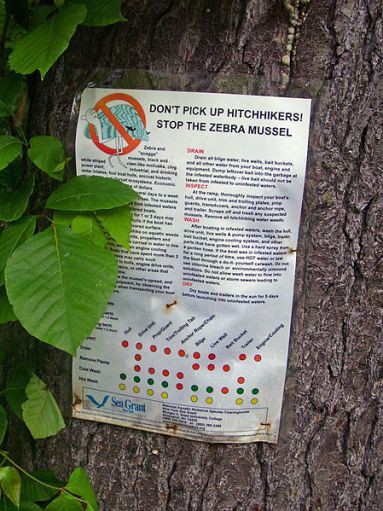
Clean your boat thoroughly after use, and avoid traveling with wild plants and animals.
Your pet is also considered to be an exotic species. Don’t let your pets hunt birds or wild animals.
Practice Sustainable Management on Your Own Land, Even If it is “Only” a Small Yard
Minimize nonpoint source pollution by using organic or natural pesticides and fertiliz- ers.
Plant shade trees for air-conditioning and to absorb CO2.
Water plants and lawns in the evening.
Better yet, use native and/or drought-tolerant plants for landscaping.
Remember that City, County, State, and Federal lands are your lands, too. Get involved in local zoning and land use planning to ensure that development follows sustainable guidelines.
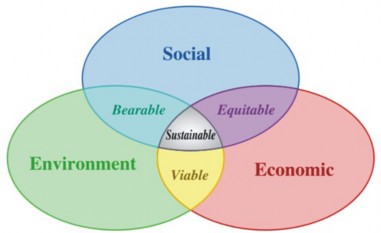
Adopt and Spread Sustainable Perspectives and Philosophy
Focus on diversity as a whole – genes, communities and ecosystems – rather than single “poster” species.
Support the inclusion of ecosystems services in economic valuations.
Encourage protection of areas large enough to accommodate migration, flooding, buffer zones, pollution from nearby development, and people and their activities.
Realize that inequitable distribution of population, land, resources, education, and wealth threatens biodiversity.
Promote the concept of sustainability as a guide for conservation decisions (Figure 18.21).
Join philosophers and religious and community groups to explore environmental ethics.
Help everyone understand basic ecology and the wealth of biodiversity shaped by bil- lions of years of evolution.
Learn More!
About the species with which you share the Earth.
About local, national, and international threats to biodiversity
About more solutions as they develop
Jump in! Join local groups which monitor ecosystem health: Frog Watch, River Watch, or Bird Counts.
Educate yourself about complex issues such as government subsidies and new tech- nologies.
Find out about local protected lands and volunteer your time and energy to restore native ecosystems.
Activate!
Exercise your citizenship to protect biodiversity. Vote, communicate your views, and push for stronger environmental protection laws.
Support organizations which promote national reserves, international treaties, and re- source conservation.
Support efforts by zoos, arboretums, museums and seed banks to help maintain genetic diversity through research, breeding, educational, and fundraising programs.
Lesson Summary
Like all species, humans depend on land, water, air, and living resources for food, energy, clothing, and ecosystem services such as nutrient recycling, waste disposal, and renewal of soil, freshwater, and clean air.
Unlike other species, human technology supplements “natural” energy resources with fossil fuels and exploits both biotic and abiotic resources and produces wastes beyond the biosphere’s capacity for renewal.
Biodiversity encompasses all variation in living systems, including genetic, species, and ecosystem diversity.
Scientists do not know how many species currently inhabit the Earth; the vast majority of Bacteria and Archaea, Protists and Insects, are probably unknown. We discover new species of animals, plants, and fungi each year.
About 1.8 million species have been identified, and most estimates of Earth’s overall species biodiversity fall between 5 and 30 million.
In general, biodiversity is highest near the equator, and decreases toward the poles.
Biodiversity “hotspots” such as the California Floristic Province and unique habitats such as bogs occasionally disrupt the overall pattern.
The fossil record and DNA analysis reveal a gradual increase in Earth’s biodiversity after the first prokaryotes appeared roughly 4 billion years ago.
Within the past 600 million years, a more detailed fossil record shows increasing bio- diversity interrupted by five major extinctions in which at least 50% of species disap- peared.
According to a 1998 survey by the American Museum of Natural History, more than 70% of biologists consider the present era to be a sixth mass extinction event.
Many scientists regard the Ice Age extinctions of large birds and mammals as the beginning of a continuum of extinctions caused by human activity which extends to the present.
Dramatic losses of large mammal species follow a pattern of human dispersal across the globe from tens of thousands of years ago in Indonesia to just over 1,000 years ago in New Zealand, and over 20% of all bird species have become extinct within the past 1,100 years.
Rates of extinction have accelerated in the past 50 years; current estimates include 3 species per hour and as many as 140,000 per year.
In 2002, Harvard biologist E.O. Wilson predicted that if current rates of extinction continue, 50% of plant and animal species will be lost within the next 100 years – com- pared to hundreds of thousands or even millions of years for previous mass extinctions.
Direct economic benefits include the potential to diversify our food supply, resources for clothing,shelter, energy, and medicines, a wealth of efficient designs which could inspire new technologies, models for medical research, and an early warning system for toxicity.
Ecosystem services provided by biodiversity include ecosystem stability and produc- tivity; maintaining and renewing soils, water supplies, and the atmosphere; nitrogen fixation and nutrient recycling; pollination, pest and disease control, and waste dis- posal.
Less tangible but equally important are the cultural, aesthetic, and spiritual values and the importance of biodiversity to many modes of recreation.
Finally, many people believe that biodiversity has intrinsic value, inherent in its exis- tence.
Human hunting, secondary effects on other species, disease carried and predation by exotic animals, and habitat destruction contributed to Ice Age extinctions.
Habitat loss, including degradation and fragmentation, is the primary cause of extinc- tion today; agriculture and deforestation continue to claim vegetated land and pollute both fresh and salt water seas.
Slash-and-burn agriculture is destroying tropical forest at rates which could result in
total loss by 2090.
In the U.S., agriculture has eliminated 50% of wetlands and 99% of tallgrass prairies.
Logging and development have destroyed more than 90% of Temperate Rainforest in the U.S.
Exotic species disrupt food chains and entire ecosystems to contribute to extinction.
The modern equivalent to overkill, overexploitation of economically important species and ecosystems, threatens fisheries, tropical rain forests, whales, rhinos, large carni- vores and many other species.
Global climate change caused by the burning of fossil fuels disrupts weather patterns and, as it has throughout Earth’s history, holds the potential to force the extinction of carefully adapted species.
Pollution of land, air, and water poisons life and destroys ecosystems.
Between 1960 and 1999, the Earth’s human population increased from 3 billion to 6 billion people. Overpopulation combined with unequal distribution of resources dra- matically intensifies pressures on biodiversity.
Our daily activities and decisions can significantly help to protect biodiversity.
After reducing consumption and reusing and recycling, careful consumption can help to conserve ecosystems.
Local, seasonal products save energy costs for transportation.
Durable and efficient products reduce long-term resource consumption.
Wise use of water resources helps to prevent desertification of ecosystems.
Energy alternatives to fossil fuels reduce greenhouse gases, although nuclear energy has its own dangers.
After minimizing waste, best practices for waste disposal ensure less pollution of ecosys- tems.
The threats to biodiversity posed by exotic species mean that everyone should learn to avoid transporting them.
Sustainable management of land, from small yards to local, state, and federal lands, conserves ecosystems.
Sustainability as a guide for decision-making balances social, economic, and environ- mental values to structure human activities such that they can continue indefinitely.
Learning about biodiversity and ecology is an important part of valuing and protecting the diversity of life.
Voting, membership in conservation organizations, and working toward protective leg- islation can contribute to genetic, species, and ecosystem diversity.
Review Questions
Explain how his laws govern the way nature does – and humans should – use energy and material resources in order to protect biodiversity.
Further Reading / Supplemental Links
Compare humans to other species in terms of resource needs and use and ecosystem service benefits and effects.
Define biodiversity and explain its three major components.
Give the three quantitative values for Earth’s species diversity, and compare biodiver- sity across the Earth’s surface and throughout the history of life.
Construct a chart showing why you consider biodiversity important. Your chart should include four categories (of the five presented in the chapter, or of your own choosing) and the 2-3 examples from each chapter that you consider most critical).
Analyze humans’ role in extinctions by comparing the causes we think contributed to the Ice Age extinctions to the causes important to extinction today.
How might Tallgrass Prairies, the Brown Tree Snake, the Atlantic Cod, and the Pere- grine Falcon serve as “poster species” to explain and highlight some of the causes of extinction?
“Reduce, Re-use, and Recycle” is so familiar to many people that it has lost much of its meaning. Yet it remains an efficient summary of the best conservation principles. Explain. Choose one new idea to add to these workhorses.
What two (or three) ecological principles can govern your food choices to help protect your health, biodiversity, and even global stability?
How does the concept of sustainable use differ from “reduce, re-use, and re-cycle”? How is it similar?
According to Barry Commoner, there are Four Laws of Ecology:
Everything is connected to everything else.
Everything must go somewhere.
Nature knows best.
There is no such thing as a free lunch.
Aldo Leopold, Round River: from the Journals of Aldo Leopold. Ed: Luna B. Leopold, 1953, Oxford University Press, New York.
Aldo Leopold, Thinking Like a Mountain.
Center for Biodiversity and Conservation, Living With Biodiversity: What You Can Really Do For the Environment. American Museum of Natural History, 2007. Available online at:
http://research.amnh.org/biodiversity/center/living/intro/index.html
Biodiversity and Your Food at:
http://research.amnh.org/biodiversity/center/living/Food/index.html
Biodiversity and Your Water Supply at:
http://research.amnh.org/biodiversity/center/living/Water/index.html
Biodiversity and Your Energy Use at:
http://research.amnh.org/biodiversity/center/living/Energy/index.html
Biodiversity and What You Buy at:
http://research.amnh.org/biodiversity/center/living/Buy/index.html
Joan Chevalier, Joel Cracraft, Francesca Grifo, and Curt Meine. Biodiversity, Science, and the Human Prospect. Center for Biodiversity and Conservation of the American Museum of Natural History, 1997. Available online at:
http://cbc.amnh.org/center/pubs/pubscbc.html
Curt Meine, Humans and other Catastrophes: Perspectives on Extinction. Center for Biodiversity and Conservation of the AMNH, editors Marc Lecard, Valeda Slade, 1999. Available online at
Francesca Grifo and Joshua Rosenthal, editors, Biodiversity and Human Health: A guide for policymakers. Center for Biodiversity and Conservation of the AMNH, 1997. Available online at:
http://www.amnh.org/education/resources/card_frame.php?rid=1282& rurlid=1197
Melanie Stiassny, It Takes All Kinds to Make A World (Marine Biodiversity). AMNH
Center for Biodiversity and Conservation Resources for Learning. Available online at:
http://www.ology.amnh.org/marinebiology/ittakesallkinds/index.html
The World Conservation Union (IUCN), 100 of the World’s Worst Invasive Alien Species: A Selection from the Global Invasive Species Database. Invasive Species Spe- cialist Group (ISSG), Auckland, New Zealand, nd. Available online at:
http://www.iucn.org/places/medoffice/invasive_species/docs/invasive_species_ booklet.pdf
Daniel P. Faith, Biodiversity. Stanford Encyclopedia of Philosophy, Metaphysics Re-
search Lab, CSLI, Stanford University, 2003. Available online at:
http://plato.stanford.edu/entries/biodiversity/
Cox, Tony, Dead zone is price gulf coast pays as farms cash in on ethanol. Bloomberg.com, 23 July 2007. Available online at:
http://www.bloomberg.com/apps/news?pid=20601109&sid=a4Tb2AFv6CRk&# 38;amp;refer=home
The Grand Banks and the Flemish Cap, in Overfishing and International Ocean Fish-
eries Governance, Government of Canada, 23 January 2007. Available online at
http://www.dfo-mpo.gc.ca/overfishing-surpeche/media/bk_grandbanks_e.htm
Chensheng Lu, Kathryn Toepel, Rene Irish, Richard A. Fenske, Dana B. Barr, and Roberto Bravo, Organic Diets Significantly Lower Children’s Dietary Exposure to Organophosphorus Pesticides. Environmental Health Perspectives Online, 1 Septem- ber 2005. Available online at
http://www.ehponline.org/members/2005/8418/8418.pdf
J. Emmett Duffy, Biodiversity. Encyclopedia of the Earth, last updated 30 October
2007. Available online at:
http://www.eoearth.org/article/Biodiversity
What Percent of Municipal Solid Waste (MSW) is Electronics? eCycling, US Environ- mental Protection Agency, last updated 6 November 2007. Available online at:
http://www.epa.gov/epaoswer/hazwaste/recycle/ecycling/faq.htm#cell
Crop Genetic Diversity and Domestic Animal Diversity Biological Diversity in Food and Agriculture, Food and Agriculture Organization of the United Nations, nd. Available online at:
http://www.fao.org/biodiversity/
David Tilman and John A. Downing, Biodiversity and stability in grasslands. Nature
367, 363 - 365 (27 January 1994). Available online at:
http://www.nature.com/nature/journal/v367/n6461/abs/367363a0.html
David Tilman, David Wedin & Johannes Knops, Productivity and sustainability in- fluenced by biodiversity in grassland ecosystems. Nature 379, 718 - 720 (22 February 1996). Available online at:
http://www.nature.com/nature/journal/v379/n6567/abs/379718a0.html
Ransom A. Myers and Boris Worm, Rapid worldwide depletion of predatory fish com- munities. Nature 423, 280-283 (15 May 2003). Available online at:
http://www.nature.com/nature/journal/v423/n6937/abs/nature01610.html
Facts about Coral Reefs, Coral Reefs of the Tropics. The Nature Conservancy, 2007. Available online at:
http://www.nature.org/joinanddonate/rescuereef/explore/facts.html
Joseph Priestley, Experiments and Observations on Different Kinds of Air. Book IX, Experiments and Observations related to Vegetation and Respiration, 1790. Available online at:
http://www.spaceship-earth.org/OrigLit/JP3-911.htm
Nitrogen Pollution and Agriculture WikiStrategy, Nitrogen Wiki, Nitrogen Pollution and Agriculture: A Collaborative Strategy Forum hosted by the David and Lucile Packard Foundation. Available online at:
https://nitrogen.packard.org/Nitrogen%20Wiki/Home.aspx
Ian Harrison, Melina Laverty, Eleanor Sterling, Species Diversity. Connexions, last edited 29 July 2004. Available online at:
http://cnx.org/content/m12174/latest/
James Gibbs, The Importance of Biodiversity: An Exercise. Connexions, last edited 14 July 2004. Available online at:
http://cnx.org/content/m12175/latest/
http://www.amnh.org/education/resources/card_frame.php?rid=1121& rurlid=1066
http://www.sp2000.org/index.php?option=com_content&task=view& amp;id=76&Itemid=73
http://www.actionbioscience.org/newfrontiers/eldredge2.html
http://www.sciam.com/askexpert_question.cfm?articleID=000B012D-7016-1C72-9EB7809EC5 38;amp;catID=3&topicID=3
http://www.environment.gov.au/biodiversity/publications/series/paper1/index.
http://stort.unep-wcmc.org/imaps/gb2002/book/viewer.htm
http://www.greenfacts.org/en/biodiversity/biodiversity-greenfacts-level2. pdf
http://www.biodiversityproject.org/biodiversity.htm
http://ology.amnh.org/biodiversity/
http://www.biodiversity911.org/
http://www.motherjones.com/commentary/columns/2007/03/iwaste.html
http://www.eco-action.org/dt/thinking.html
Vocabulary
air pollution Alteration of the Earth’s atmosphere by chemical, particulate, or biological materials.
biodiversity hotspot A biogeographic region which has lost at least 70% of its original habitat, yet contains at least 1500 endemic species of vascular plants.
biodiversity Variation in life – at all levels of organization: genes, species, and ecosystems.
biological magnification (food chain concentration) The process in which synthetic chemicals concentrate as they move through the food chain, so that toxic effects are multiplied.
bionics Engineering which uses biological organisms’ design principles to develop efficient products.
carbon sequestration Process which removes CO2 from the atmosphere. desertification Degradation of formerly productive land (usually at least semi-arid). ecosystem diversity The variety of ecosystems on Earth.
ecosystem services Indirect benefits provided by ecosystem processes, such as nutrient cycling and waste disposal.
ecosystem A functional unit comprised of living things interacting with their nonliving environment.
endemic A unique species found only within a certain area and nowhere else.
epiphyte Plant which grows on top of another plant.
exotic (alien) species A species introduced either intentionally or unintentionally to a completely new ecosystem – a non-native species.
extirpation Elimination of a species from a particular region of its range.
genetic diversity Variation among individuals and populations within a species.
genetic pollution Hybridization or mixing of genes of a wild population with a domestic or feral population.
global warming The recent increase in the Earth’s average near-surface and ocean tem- peratures.
greenhouse effect The trapping by the atmosphere of heat energy radiated from the Earth’s surface.
keystone species Species having a functional importance to ecosystem diversity and sta- bility which far outweighs its numerical or mass importance.
monoculture Large-scale cultivation of single varieties of single species.
natural resource Something supplied by nature which supports life, including sources.
pollution Release into the environment of chemicals, noise, heat or even light beyond the capacity of the environment to absorb them without harmful effects on life.
salination Increase in salt levels in soils.
species diversity The number of different species in an ecosystem or on Earth.
sustainable forest management Forest management which ensures that the goods and services yielded from a forest remain at a level that does not degrade the environment or the potential for similar levels of goods and services in the future.
sustainable use Use of resources at a rate which meets the needs of the present without impairing the ability of future generations to meet their needs.
Points to Consider
Most of this lesson considered species and ecosystem diversity. Why is genetic diversity also very important?
How does biodiversity in your area compare to the general global pattern of biodiver- sity? Give some reasons why it may or may not follow general trends.
Choose one other area in which you are interested, and make the same comparison.
Do you find the extinction statistics presented in this lesson alarming? Why do you think we don’t hear more about the Sixth Extinction and the predicted loss of biodi- versity?
Which values of biodiversity do you feel are most compelling?
Which solutions will you adopt in your daily life?
- Log in or register to post comments
- Email this page
